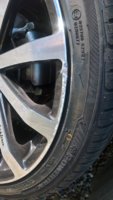Thanks
@DXX, with the greatest respect I agree and disagree.
I'm with you on the added rotating mass creating additional inertia, but this does not affect the driveshafts any more than the overall weight in the van when accelerating/decelerating. I'll hold my hands up and say I'm not 100% sure on this but have yet to see a convincing argument otherwise, but think on this - when you accelerate and the engine, via the gearbox, spins the driveshafts and wheels, do the drive shafts spin about the engine or the engine (and rest of the van) around the drive shafts? It depends where you are and we naturally assume the former, but if you're sat on the driveshaft it's the other way round. As I see it both the wheels and the van itself are being forced against each other in different directions, my few bags of sand analogy may be a little simplistic, as it will depend on the weight of the wheels, their speed and the number of bags of sand.
And when you brake, although the brakes act on the wheels, they have to reduce the kinetic energy (which is a product of the speed and total weight of the vehicle) of the whole vehicle (converting it to heat), which then results in the drive shafts slowing at a given rate, so it is the brakes that affect the force that goes back through to the gearbox. In fact, if you decelerate with heavier wheels (not using the brakes), the added inertia will prevent the vehicle from slowing so quickly and therefore will lessen the forces. So my take is that only bigger brakes will result in more stresses on deceleration.
As I said I'm not an expert on this, just using some schoolboy physics and trying to think it through. The reason this thread is a particularly interesting one is because we are yet to get a definitive technical view on this. I would love for a mechanical engineer to show us the maths on this to put it all into context. Maybe one will be along shortly


 im going to replace the rear tyres from the 255 x 35 x 20 on at the mo for 275 x 40 x 20 to give a bit more side wall protection. As im only changing the rear tyres for larger ones making their rolling circumference bigger, am i right in thinking they wont affect gearing/speedo etc because they are not the 'driven' wheels in effect the rear wheels are just trailing wheels?
im going to replace the rear tyres from the 255 x 35 x 20 on at the mo for 275 x 40 x 20 to give a bit more side wall protection. As im only changing the rear tyres for larger ones making their rolling circumference bigger, am i right in thinking they wont affect gearing/speedo etc because they are not the 'driven' wheels in effect the rear wheels are just trailing wheels?
 Sorry to hear about your kerbing, ouch!!!
Sorry to hear about your kerbing, ouch!!! If enough van buyers wanted 20's to warrant the cost for VW you can bet they would do it too. Yep they weigh more and the gearing and attached gubbins will be different but it won't affect the gearbox. As mentioned before bigger wheels (and the increased rotational forces) impacts on the brakes, suspension and steering, the only things affecting the gearbox are the applied forces which are the engine's torque when accelerating and the brakes effectively slowing the driveshafts when decelerating, I can't see any logic in anything else, sorry, well bar the clutch maybe having a minimal effect. The gearbox warranty get out is just an excuse as far as I can see but obviously needs to be borne in mind.
If enough van buyers wanted 20's to warrant the cost for VW you can bet they would do it too. Yep they weigh more and the gearing and attached gubbins will be different but it won't affect the gearbox. As mentioned before bigger wheels (and the increased rotational forces) impacts on the brakes, suspension and steering, the only things affecting the gearbox are the applied forces which are the engine's torque when accelerating and the brakes effectively slowing the driveshafts when decelerating, I can't see any logic in anything else, sorry, well bar the clutch maybe having a minimal effect. The gearbox warranty get out is just an excuse as far as I can see but obviously needs to be borne in mind.